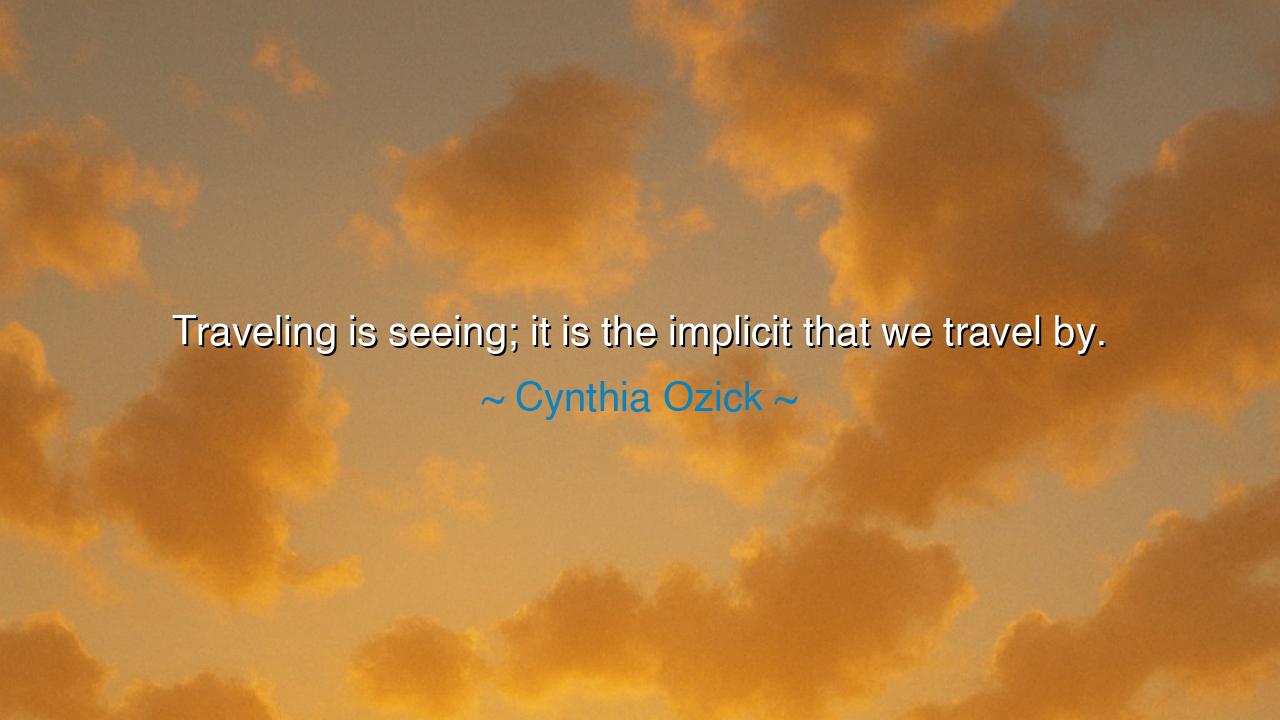
Traveling is seeing; it is the implicit that we travel by.






Hear the luminous words of Cynthia Ozick: “Traveling is seeing; it is the implicit that we travel by.” Though wrapped in simplicity, these words resound like a bell through the corridors of wisdom. For they remind us that the essence of travel is not merely the movement of the body across distances, but the awakening of the eyes, the stripping away of blindness, the opening of the soul to the unseen. To see—truly see—is the sacred act of the traveler, and it is the unspoken, the implicit, that guides and shapes every step.
To say that traveling is seeing is to declare that the highest purpose of a journey is not to arrive at monuments or to collect tokens of place, but to behold the world in its depth. Many pass through lands without vision, snapping pictures but never perceiving. Yet the true traveler walks with awakened senses: to notice the posture of a farmer in the fields, the laughter of children in alleys, the quiet sadness in a stranger’s eyes. It is this seeing, more than the miles traversed, that transforms.
And what is this implicit by which we travel? It is the hidden current, the unspoken meaning that flows beneath the surface of every encounter. When we enter a foreign market, we are not merely buying food; we are tasting history, tradition, and memory. When we hear a song in another tongue, we are not only listening to sound; we are touching the soul of a people. The implicit is the layer unseen but felt, the truth beneath appearances, the wisdom that cannot be measured in guidebooks. Ozick reminds us that this is the current that carries the true traveler forward.
Consider the journey of Marco Polo, who wandered far into the courts of Kublai Khan. He saw not only cities and palaces, but customs and beliefs unfamiliar to his Venetian eyes. What made his account endure was not the listing of places, but his vision of the implicit—the strength of Mongol order, the grandeur of their empire, the subtleties of a culture alien yet rich. His travels were powerful because he saw, and because he drew out what was hidden beneath the surface of what he saw.
We may also remember Mary Kingsley, the Victorian woman who braved the rivers and forests of West Africa. Others might have looked with prejudice or fear, but she saw differently. She sought to understand, to listen, to learn from the people she encountered. In her writings, the implicit truths of resilience, adaptation, and dignity shine forth. Her journeys remind us that seeing is not passive looking, but active recognition of what is often overlooked.
The lesson for us is profound: do not travel as one blind, collecting only the surface of things. Train your eyes to discern, your heart to perceive, your mind to draw meaning from the implicit. The true richness of a journey lies not in how many miles you walk, but in how deeply you see. If you open your eyes fully, even the road to your neighbor’s house can become a pilgrimage. If you remain blind, a thousand miles will bring you nothing.
Practically, this means: when you travel, slow down. Do not rush only to the famous sights, but pause in the unnoticed places. Listen to the cadence of local speech, notice the shapes of doors, taste the unfamiliar food with reverence, watch how people greet each other. Seek not only the explicit, but the implicit—the invisible threads that bind a people, a place, a moment in time. In doing so, you will journey not only through the world, but through the very soul of existence.
Therefore, O travelers of life, let us remember Cynthia Ozick’s words. Traveling is seeing, not merely moving. It is perceiving the implicit, not merely consuming the obvious. Walk, then, with open eyes, and you shall find that every step, every sight, every sound carries within it a secret waiting to be revealed. And when you return, you will not be the same—for you will have seen, and in seeing, you will have truly lived.






AAdministratorAdministrator
Welcome, honored guests. Please leave a comment, we will respond soon